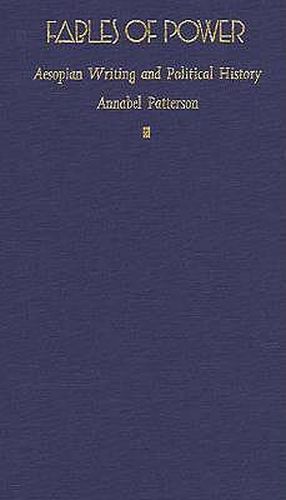Readings Newsletter
Become a Readings Member to make your shopping experience even easier.
Sign in or sign up for free!
You’re not far away from qualifying for FREE standard shipping within Australia
You’ve qualified for FREE standard shipping within Australia
The cart is loading…






In this work, Annabel Patterson traces the origins and meanings of the Aesopian fables, as well as their function in Renaissance culture. She shows how the fable worked as a medium of political analysis and communication, especially from or on behalf of the politically powerless. Patterson begins with an analysis of the legendary life of Aesop, its cultural history and philosophical implications, a topic that involves such widely seperated figures as La Fontaine, Hegel and Vygotsky. The myth’s origin is recovered here in the saving myth of Aesop the Ethiopian - black, ugly, who began as a slave but became both free and influential, a source of political wisdom. She then traces the early modern history of the fable from Caxton, Lydgate and Henryson through the 18th century, focusing on such figures as Spenser, Sidney, Lyly, Shakespeare and Milton, as well as the lesser-known John Ogilby, Sir Roger l'Estrange and Samuel Croxall. Patterson discusses the famous fable of The Belly and the Members , which because it articulated in symbolic terms some of the most intransigent problems in political philosophy and practice, was still going strong as a symbolic text in the mid-19th century, when it used by both Karl Marx and George Eliot. Fables of Power offers a contribution to the fields of Renaissance studies, literary history and cultural studies generally.
$9.00 standard shipping within Australia
FREE standard shipping within Australia for orders over $100.00
Express & International shipping calculated at checkout
In this work, Annabel Patterson traces the origins and meanings of the Aesopian fables, as well as their function in Renaissance culture. She shows how the fable worked as a medium of political analysis and communication, especially from or on behalf of the politically powerless. Patterson begins with an analysis of the legendary life of Aesop, its cultural history and philosophical implications, a topic that involves such widely seperated figures as La Fontaine, Hegel and Vygotsky. The myth’s origin is recovered here in the saving myth of Aesop the Ethiopian - black, ugly, who began as a slave but became both free and influential, a source of political wisdom. She then traces the early modern history of the fable from Caxton, Lydgate and Henryson through the 18th century, focusing on such figures as Spenser, Sidney, Lyly, Shakespeare and Milton, as well as the lesser-known John Ogilby, Sir Roger l'Estrange and Samuel Croxall. Patterson discusses the famous fable of The Belly and the Members , which because it articulated in symbolic terms some of the most intransigent problems in political philosophy and practice, was still going strong as a symbolic text in the mid-19th century, when it used by both Karl Marx and George Eliot. Fables of Power offers a contribution to the fields of Renaissance studies, literary history and cultural studies generally.